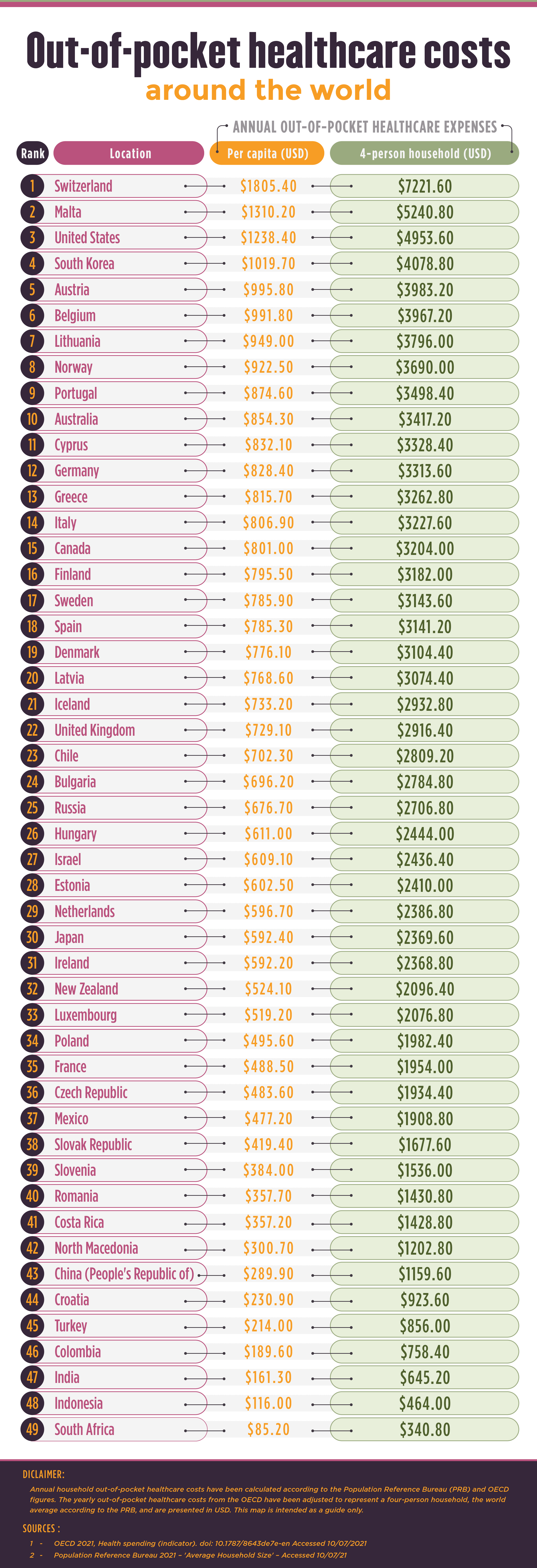The Burrow

When you’re out of action, the last thing you want to be worrying about is how much a trip to the dentist, specialist, or hospital will cost you. But while necessary, getting better isn’t always free, with out-of-pocket costs varying from country to country. As experts in health insurance, Compare the Market wanted to find out how much you may pay for your healthcare.
This feature will explore average annual out-of-pocket healthcare costs worldwide – looking closely at the countries with the highest spends and the lowest – using the latest data ranging from 2018 – 2020 from the Organisation for Economic Co-operation and Development (OECD).
The OECD defines out-of-pocket expenses as a direct payment for services from the household primary income or savings.¹ In healthcare, out-of-pocket simply refers to the costs paid for health services after insurance and other subsidies. On average, out-of-pocket healthcare costs account for more than 20% of total health spending across the 36 countries of the OECD.¹ Out-of-pocket spending is made up of:
The table below reveals annual out-of-pocket healthcare expenses in 49 countries per capita. These figures are in US dollars. These figures are averages and may not indicate what individuals actually pay for healthcare in each country.

With its global reputation for having an exceptional healthcare system,⁴ Switzerland has ranked highest for out-of-pocket healthcare spending amongst the 49 countries listed by the OECD.² OECD estimates have found that the average annual out-of-pocket spend on healthcare is US$1,805.40 per capita.² A study of 19 EU countries found that Switzerland’s out-of-pocket spending compared to overall healthcare costs was high relative to other European countries, accounting for 28.95% of all expenditure.⁵
This could be partly due to the universal health coverage in the country, which requires each resident to purchase a health insurance plan for themselves and dependents, such as children.⁶ The minimum annual deductible is CHF 300 (US$328*) for adults, although around 46% choose a model with a higher deductible amount.⁶ According to the Swiss Federal Department of Home Affairs, monthly premiums also rose in 2021, amounting to CFH 316.50,⁷ or USD $346*.
Much like Switzerland, Malta is uniquely known for its high standards of healthcare services, ranked fifth globally by the World Health Organisation.⁸ With both tax-supported public and voluntary private healthcare systems, health-related spending in Malta is somewhat variable. The OECD estimates annual out-of-pocket healthcare expenses of around US$1,310.20 per capita.²
While the public sector is mainly covered, the private healthcare system requires significant out-of-pocket payments, accounting for around a third (31%) of total health expenditure.⁹ Many Maltese residents report that out-of-pocket payments are the primary source of funds buying medicines, paying private GPs and private specialist consultations.⁹
Well known for its lack of universal health care, it’s no surprise that out-of-pocket healthcare spending is high in the US, with the average US resident paying around 11% of total health spending out-of-pocket on expenses such as copayments for the GP, prescription drugs and health insurance deductibles.10 The OECD estimates each individual in the US pays around US$1,238.40 a year out-of-pocket toward healthcare.2
Roughly a quarter of all healthcare spending in the US goes toward professional services such as dentistry, which makes up the largest share of total out-of-pocket spending (38%).11 Prescription drugs make up 9% of total expenditure and 13% of total out-of-pocket expenses.11 To put this into context, in 2019, spending on professional services was US$772.1 billion in 2019, and US$369.7 billion for prescription drugs.12
The country offering the cheapest out-of-pocket expenses for healthcare, according to the OECD, is South Africa, at an annual average of US$85.20 per capita.² While both public and private healthcare is available, around 80% of South Africans opt for public care. Most public healthcare services are subsidised up to 40% of total costs, varying based on income.13 Doctor visits can cost around R 5513 or US$3.80*.
But while healthcare costs are low, waiting lists can be long and hospitals under-resourced. Both life expectancy and self-evaluated healthiness were lower in South Africa than OECD averages, as these are generally associated with both a higher per capita health care spend and living standards, lifestyles and environmental factors.14
According to the OECD, Indonesians are spending around US$116 annually on out-of-pocket healthcare.² In 2014, the Indonesian government launched Jaminan Kesehatan Nasional (JKN) to implement universal health care, funded by the government and taxpayers. In a review of its implementation, a survey was completed, revealing that only around 18% of respondents paid out-of-pocket at health care facilities.15
Most of these costs came from medicines, which accounted for around 70% of all out-of-pocket expenses.15 The lowest-paid unskilled government worker on RP 20,700 a day (US$2.35*) can cover the cost of generic medicines to treat acute diseases and chronic conditions in as little as 0.2 days and up to 17 days.16
The OECD estimates that residents of India pay around US$161.30 annually out-of-pocket for healthcare.² Despite this, out-of-pocket health expenditure is still high, accounting for 62.66% of total healthcare spending, primarily due to the absence of widespread health insurance.17 While the Indian Government offers many public healthcare programs that cover hospital costs for those below the poverty line, coverage isn’t comprehensive.18
When looking at out-of-pocket health care costs as a percentage of GDP, Indians actually pay more than residents of other countries.2 The low out-of-pocket expenses can be attributed to general low healthcare costs, around 5% to 10% of healthcare spending in the US.
*All currency conversions completed on 12/07/21 using Xe Currency Converter
Brought to you by Compare the Market: Making it easier for Australians to search for great deals on Health Insurance.